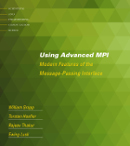Home
Publications
edited volumes
Awards
Research
Teaching
Miscellaneous
Full CV [pdf]
BLOG
bio


Events





Past Events






|
Publications of Torsten Hoefler
Jens Domke, Torsten Hoefler, Satoshi Matsuoka:
| | | Fail-in-Place Network Design: Interaction between Topology, Routing Algorithm and Failures
(presented in New Orleans, LA, USA, Nov. 2014, Proceedings of the International Conference on High Performance Computing, Networking, Storage and Analysis (SC14) )
AbstractHardware failures in networks are omnipresent and
often inevitable. The growing system size of high performance
computers results in a steady decrease of the mean time between
failures. Exchanging network components often requires whole
system downtime which increases the cost of failures. In this
work, we study a fail-in-place strategy where broken network
elements remain untouched for longer periods of time. Each
hardware failure of a network component will decrease the overall
bandwidth of the network and the rerouting delay will cause
disconnects for a subset of the paths. We show, that a fail-in-place
strategy is feasible for today’s networks and the degradation is
manageable, and provide guidelines for the design. Our network
failure simulation toolchain allows system designers to extrapolate
the performance degradation based on expected failure rates,
and it can be used to evaluate the current state of a system.
In a case study of real-world HPC systems, we will analyze the
performance degradation throughout the system’s lifetime under
the assumption that faulty network components are not repaired,
which results in a recommendation to change the used routing
algorithm to improve the network performance as well as the
fail-in-place characteristic. We firmly believe that fail-in-place is
a practical strategy to move towards the next-generation large-scale networks.
Documentsdownload article: 
download slides: 
| | | BibTeX | @inproceedings{fail-in-place,
author={Jens Domke and Torsten Hoefler and Satoshi Matsuoka},
title={{Fail-in-Place Network Design: Interaction between Topology, Routing Algorithm and Failures}},
year={2014},
month={Nov.},
location={New Orleans, LA, USA},
note={Proceedings of the International Conference on High Performance Computing, Networking, Storage and Analysis (SC14)},
source={http://www.unixer.de/~htor/publications/},
} |
|
|



























